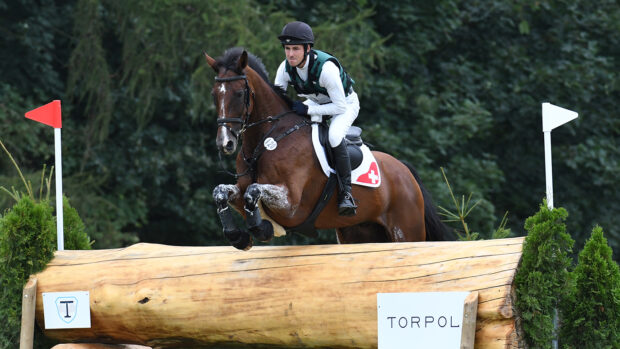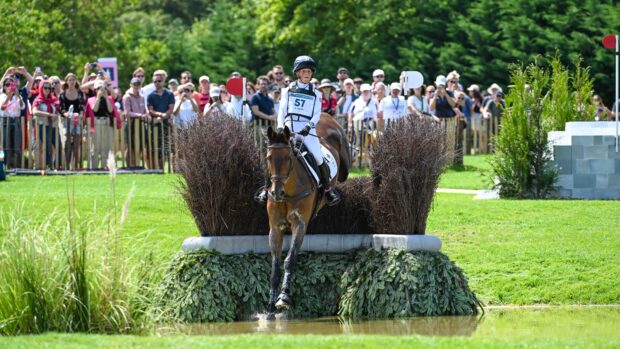Ditches
- When first approaching a ditch, let him know what he is going to jump. Do not try to gallop him over it without him realising what is there.
- Walk the horse up to the ditch, allow him to sniff and look in it. He will pop over from a standstill. As he grows in confidence, hewill realize there is nothing difficult.
- Trot your horse up to the ditch and then come back to a walk until he is ready to take it on but do not let him turn away.
- Ride the horse softly while he is thinking about going but harder if hedecides not to go and wants to back off.
Take your horse schooling several times, preferably at different places, as it can take months or even years before horses feel comfortable about jumping ditches.
Jumping water obstacles
When meeting water for the first time, walk the horse up and allow him to fidget on the edge before stepping in. Do not exert any pressure on him unless he tries to run backwards. If the horse is still thinking forward, be as soft as you can.
When riding a horse into water for the first time, he will quite often leap in and you should try not to be caught off guard and catch him in the teeth.
Instead, hold onto the mane or the breast plate. Remember to allow the horse freedom and be prepared to slip the reins when he leaps out of greenness.
Drop fences
You do not want to allow your horse to leap bravely down drop fences as the larger jump he takes, the harder it will be on his legs.
Sometimes, it is necessary to attack a drop because there is a ditch or bank on the other side but it is always safer to land gently.
It is important that your weight does not fall forward over drop fences, as this magnifies any possible problems.
When taking-off, the rider’s body should be upright with very little fold. The drag effect on the horse throws you forward, so it is imperative to keep your weight back.
If possible, ride in a flat jumping saddle without a high cantle, asthe further you stay back, the more likely you are to sit on the cantle.
If you ride with long stirrups, it is more difficult to keep your lower leg forward. You may also find it better if your jumping saddle has forward cut flaps like on a classical old hunting one.
Tackling steps
When jumping down steps, slip the reins through your fingers to allow the horse freedom when you are leaning back. But this does create problems in competitions where there is a jump at the bottom and the horse must stay straight.
Riders have to be very quick in taking up the contact by bringing their hands up and back, as there is not time to gather the reins up.
Try not to let the reins droop and go loose on landing, even ifthere is not a jump in front of you. If you do slip the reins, you have to be quick to regain control to keep the direction.
Staying straight
Once both you and your horse are happy about taking on cross-country obstacles, the next stage is to improve your accuracy.
Before attempting fixed corners cross-country, you should have practised at homes.Start by building arrowheads and corners with show jumps and gradually increase your angle of approach.
When walking a cross-country course, dissect the corner and imagine a rail coming down the centre of the fence at an angle of 90 degrees.
The temptation is to jump the corner at the narrowest part but this is where a lot of run-outs occur.
You must look at the minimum and the maximum spread you can jump and then ride for the middle of these two points. This is usually a lot further away from the point of the corner than you first imagine.
Sometimes, in combination fences, your line will be dictated by the ground, a tree or the direction to the next jump. Always be aware of this when walking the course.
Arrowheads, which are becoming popular with course-builders, are a kinder type of fence. If a rider hooks back too much,there is more time for the horse to see a way out. But how fast you approach the jump will depend on the distance in the combination ¢ whether it is short or long.
If you ignore the distance built, you are going to come to grief, as the horse will not be able to cope.
When walking the course, always consider what could go wrong at different fences. For example, at arrowheads, the horse could run out or if he jumps in too deep, he may tip up. But if he takes off too far away,he will not be able to stretch and get out.
The reason for looking at what could go wrong is so that the rider is aware of any possible problems and if the symptoms occur, can make corrections. If the rider does not recognise the symptoms, they can grow into a full-blown disaster.
People argue that this is a negative attitude to adopt but it is an important part of not letting a little mistake develop into a big one.
| Click here to subscribe to HORSE magazine, which is packed with horsecare features every month |



